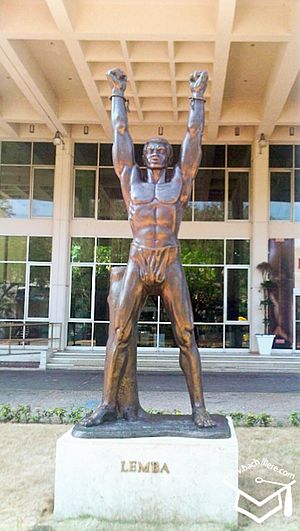Sebastián Lemba facts for kids
Quick facts for kids
Sebastián Lemba
|
|
|---|---|

Painting of Lemba
|
|
| Born | c.1510 – 1520 |
| Died | September 25, 1547 or September 25, 1548 San Juan de la Maguana, Captaincy General of Santo Domingo
(now San Juan de la Maguana, Dominican Republic) |
| Cause of death | Execution |
| Other names | Juan Sebastián Lemba Calembo |
| Occupation | Maroon leader |
| Years active | 1532 - 1547 |
| Awards | National hero |
Sebastián Lemba was an important leader in the Dominican fight against slavery. He led a long rebellion of "maroons" in the colony of Santo Domingo. This area is now known as the Dominican Republic.
Lemba was born in Africa. He was part of the Lemba tribe, which is where his name comes from. Around 1525, when he was young, he was captured. He was taken to companies in France and Spain. Later, he was brought to the island of Hispaniola.
Lemba was very tired of the harsh life of slavery. In 1532, he decided to rebel against the Spanish rulers. His rebellion was successful. He wanted to free the island from slavery. Lemba led a "maroon" rebellion for 15 years. This rebellion became one of the first major maroon activities in all of the Americas.
Contents
Who Was Sebastián Lemba?
Early Life and Background
We don't know the exact date or place where Sebastián Lemba was born. But historians believe he was born in West Africa. This was likely between the years 1510 and 1520.
His mother was from the Lemba tribe. His father was from the Calembo tribe, part of the Kongo people. This explains his full name, Juan Sebastián Lemba Calembo.
Around 1525, young Lemba was captured. He was brought to the Caribbean island called Hispaniola. At that time, Spain ruled Hispaniola as the colony of Santo Domingo. This was the first European colony in the New World.
Life on Hispaniola Island
Before the Spanish arrived, the Taínos lived on Hispaniola. They were an indigenous tribe who spoke Arawak. They had lived there for thousands of years. The Taínos called the island Quisqueya and Aytí.
Their peaceful lives were sometimes disturbed by the Caribs, another indigenous tribe. By 1492, many Taínos were looking for protection. Their lives changed when Italian explorer Christopher Columbus arrived. He claimed the island for Spain, and they renamed it Hispaniola.
At first, the Taínos and Spanish colonists got along. But soon, things turned bad. The Spanish began to take the Taínos' gold by force. They also enslaved them and treated them cruelly. This caused the Taínos to fight back. These fights grew into bloody wars between the Taínos and the Spanish.
By the early 1500s, the Taíno population had almost disappeared. This was mostly due to diseases. Wars, abuse, and mixing with the Spanish also played a part.
Slavery in Santo Domingo
Around this time, slavery of Taínos became illegal. A Dominican friar named Bartolomé de las Casas helped make this happen. He suggested that the Spanish bring enslaved Africans to work instead. This made Santo Domingo the first colony to bring enslaved Africans.
The first Africans to arrive were called Black Ladinos. These were Christian Africans who had adopted Spanish culture. They were brought to replace the Taínos. But life for these new Africans was also very hard. They were forced into difficult labor on plantations. They had no rights or freedom. They also faced a lot of racism. This terrible experience pushed many to escape. Others planned to revolt.
On December 25, 1521, Maria Olofa and Gonzalo Mandinga led the first major slave revolt in the Americas. This revolt lasted for a year. It was eventually stopped by the Spanish in December 1522. New laws were made to prevent more rebellions. Harsh punishments were put in place for anyone who tried to revolt.
But many enslaved people still managed to escape. They formed independent communities called "Maroon" communities. This first revolt helped start more rebellions. These uprisings happened not only on Hispaniola but across the Americas.
Life as an Enslaved Person
Lemba was captured by the Spanish. He arrived in the colony to work on the plantations.
Lemba's Rebellion
Around 1532, Lemba and a group of enslaved people rose up against the Spanish colony. They escaped to the mountains in the middle of the island. For several years, they fought against the Spanish authorities.
Soon, other enslaved people who had rebelled joined Lemba's group. It's thought that between 150 and 400 men fought in the rebellion. Lemba and his men acted like an army. They traveled through villages, attacking the Spanish and freeing other enslaved people.
Lemba's Death
Sebastián Lemba was captured on September 25, 1547. The exact details of his death are not completely clear. Some sources say he died between 1547 and 1548. This might have been in San Juan de la Maguana or another part of the southern country. Other stories say he died in Santo Domingo. He was captured and killed at one of the city gates there.
Lemba's Legacy
Sebastián Lemba's actions are very important in history. He was one of the first enslaved Africans to start fighting against slavery in the Americas. Lemba is honored as a national hero in the Dominican Republic. There is a statue built to remember him.
See also
 In Spanish: Sebastián Lemba para niños
In Spanish: Sebastián Lemba para niños


